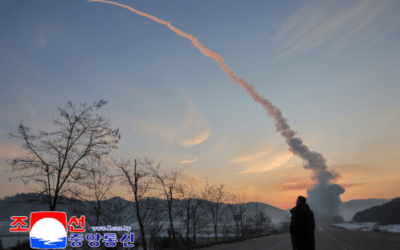North Korea launched two ballistic missiles towards its eastern waters, in a “grave provocation” on Thursday, South Korea’s Joint Chiefs of Staff said. The short-range missile launches followed the fifth and final round of Washington and Seoul’s largest-ever combined live-fire joint military exercises.
According to South Korea’s Joint Chiefs of Staff, North Korea’s missiles were launched from Pyongyang and traveled roughly 480 miles. The missiles then landed in the sea between Japan and the Korean Peninsula, within Tokyo’s exclusive economic zone, Japanese Prime Minister Fumio Kishida said.
Commemorating the 70th anniversary of the two countries’ alliance, the just concluded US-South Korean “Combined annihilation firepower drills” were the largest of their kind since they were first held in 1977. South Korea’s Defense Ministry explained that each of the five rounds “involved 2,500 South Korean and U.S. troops and about 610 military assets including stealth fighter jets, attack helicopters, tanks and drones from both countries.” Pyongyang views these massive war simulations on its doorstep as invasion rehearsals.
Some of these exercises, including simulated “artillery and aerial strikes on front-line North Korean military facilities,” took place only about 16 miles south of the demilitarized zone (DMZ).
State media in the Democratic People’s Republic of Korea (DPRK) accused Washington and Seoul of using the drills to master “military threat and blackmail and war tactics” against North Korea. Hours after the drills wrapped up, Pyongyang launched the two missiles. Additionally, 30 minutes before firing the missiles, North Korea’s military vowed an unspecified “inevitable” response to Washington’s drills with its neighbor, which it denounced as “provocative and irresponsible.”
South Korean President Yoon Suk Yeol declared that “only a strong military — which can fight and defeat the enemy and which the enemy can’t even dare to challenge — can guarantee the freedom, peace and prosperity of the Republic of Korea.” Yoon observed the drills alongside senior South Korean and U.S. military officials.
National Security Advisor Jake Sullivan reaffirmed Washington’s commitment to the defense of South Korea and Japan, during a meeting with officials from the three countries in Tokyo, the White House said. The officials were said to have discussed North Korea as well as coordination tactics in the East China Sea and the South China Sea, where the US has been carrying out a vast military buildup against China for more than a decade.
After a years-long pause, the President Joe Biden administration resumed large-scale war games targeting the DPRK. As a result, since 2022, Pyongyang has launched over 100 missiles. Earlier this year, Washington and Seoul carried out their largest live-fire field exercises in five years, the drills were dubbed “Foal Eagle.” Concurrently, the Pentagon sent MQ-9 Reaper armed drones to the Korean Peninsula for the first time.
The nuclear-powered USS Nimitz aircraft carrier as well as nuclear-capable bombers have also participated in joint exercises with South Korea this year. Last month, during a meeting with Yoon, Biden promised the US would periodically dock U.S. nuclear-armed submarines in South Korea.
Last year, Washington, Tokyo, and Seoul entered a trilateral defense agreement eyeing Pyongyang and Beijing. At the time, North Korea referred to this pact as an “Asian version of NATO.” Ancillary to the Pentagon’s “pivot to Asia,” an encirclement of China, Japan announced it would double its military budget over five years and increase military cooperation with the US.
The Joe Biden administration’s North Korea policy is far more hawkish than the status quo during the last half of the Donald Trump administration, where war games were rolled back, dialog was opened, and all sides reduced weapons tests.
Tensions are soaring on the Korean Peninsula as crippling sanctions have been maintained indefinitely and US officials have threatened North Korea with obliteration. Biden has offered no off ramp for Pyongyang, only demanding the country agree to its own denuclearization and disarmament.
































